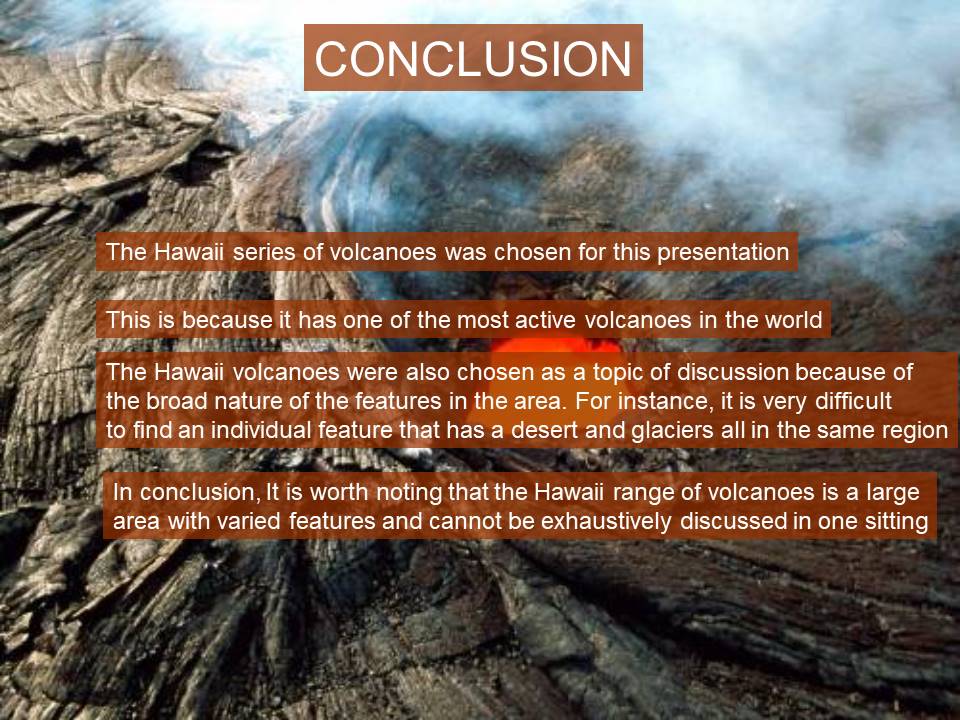Geological Features and Events
- Most of the features on the Hawaii formed primarily as a result of volcanic eruptions in the region.
- The most prominent of these features are volcanoes.
- All the volcanoes in Hawaii are shield volcanoes. They are large and have shallow-sloping sides – almost like a warrior’s shield.
- The volcanoes of the region are formed by low-viscosity lava .
- All the volcanoes in Hawaii are shield volcanoes. They are large and have shallow-sloping sides – almost like a warrior’s shield
- They are formed by low-viscosity (very runny) lava which, over time, runs down the side of the volcanic mountain and builds up a broad profile
- It is like as if you had a steep, tall mountain of sand and you poured more sand on top of the mountain. The sand would run down the sides and, if you pour enough sand, your once steep and tall mountain will now be a shallow and broad hill.
- The shield volcanoes Hawaii erupt magma as hot as 1,200 °C (2,200 °F) compared with 850 °C (1,560 °F) for most other volcanoes around the world (Garcia et al., 2000).
- The Big Island of Hawaii is totally made up of volcanoes.
- From oldest to youngest these are:
- Kohala
- Mauna Kea
- Hualalai
- Mauna Loa
- Kilauea
- Kilauea is one of the world’s most active volcanoes.
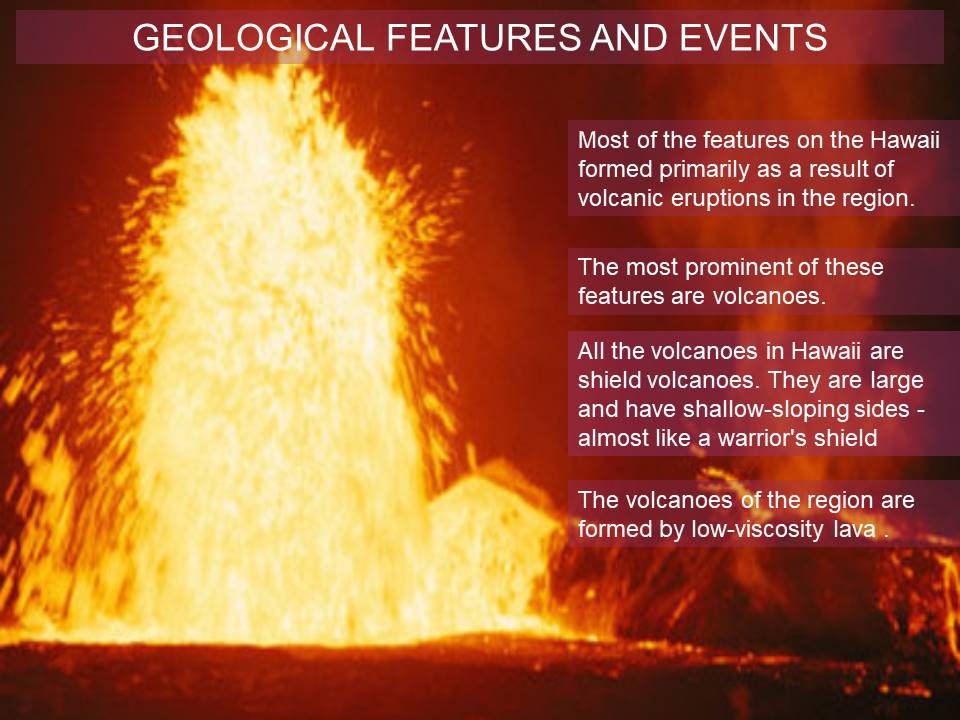
Geological Feature
Volcanoes are the most prominent features in the region. The most common parent rock material in Hawaii is the extrusive igneous rock.
The minerals that make up the extrusive igneous rocks found in the region include:
- Quartz
- Pyroxene
- Feldspar
- Mica
- Hornblende
The most common parent rock material in Hawaii is the extrusive igneous rock (Clark, 1989).
- Basalts are dark colored, fine-grained extrusive rock.
- Dacite The principle minerals that make up dacite are plagioclase, quartz, pyroxene, or hornblende.
- Gabbro- It is composed mostly of the mineral plagioclase feldspar with smaller amounts of pyroxene and olivine.
- Granite- Its minerals are quartz, feldspar, mica, and usually hornblende.
- Obsidian is a very shiny natural volcanic glass. It is produced when lava cools very quickly.
- Pumice is a very light colored, frothy volcanic rock. Pumice is formed from lava that is full of gas.
- Rhyolite is very closely related to granite. The difference is rhyolite has much finer crystals. The minerals that make up rhyolite are quartz, feldspar, mica, and hornblende.
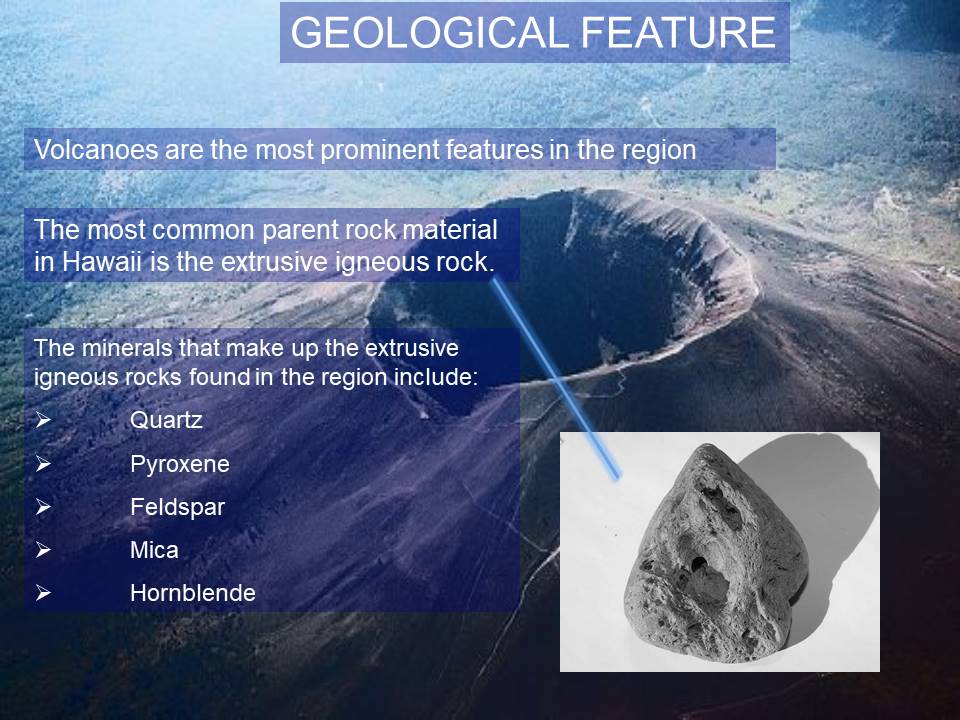
Geologic Time
The volcanoes of Hawaii are much newer, in terms of geological time.
Since it is known that the volcanoes in Hawaii are growing and their sizes are also known, their ages can be determined by simple calculations.
The volume of the oldest volcano (Kilauea) is divided by the rate of growth upto now.
Flows from last 20 years covered ~20% of Kilauea and are ~ 1-2 m thick.
Kilauea is at least 5000 m above the adjacent sea floor.
(1 m / 5000 m)/20 yrs = 1/100,000 years
(2 m / 5000m)/20 yrs = 1/50,000 years
So, it took 50,000-100,000 years to build 20% of Kilauea.
Thus, it took 250,000-500,000 years to build all of Kilauea.
- The island of Hawaii is much newer, in terms of geological time, and its volcanoes still spewing lava periodically.
- It took 250,000-500,000 years to build all of Kilauea. This is arrived at by simple mathematics.
- We know Kilauea is growing and it is known how big it is.
- If we can work out how fast it grows we can just divide the volume by the growth rate to get the age.
- Flows from last 20 years covered ~20% of Kilauea and are ~ 1-2 m thick (Fletcher, & Jones, 1996).
- Kilauea is at least 5000 m above the adjacent sea floor.
- (1 m / 5000 m)/20 yrs = 1/100,000 years
- (2 m / 5000m)/20 yrs = 1/50,000 years
- So, it took 50,000-100,000 years to build 20% of Kilauea.
- Thus, it took 250,000-500,000 years to build all of Kilauea.
Assumptions
- Things happened the same way in the past as they do now (uniformity of process).
- Things happened at the same speed in the past as they do now (uniformity of rate).
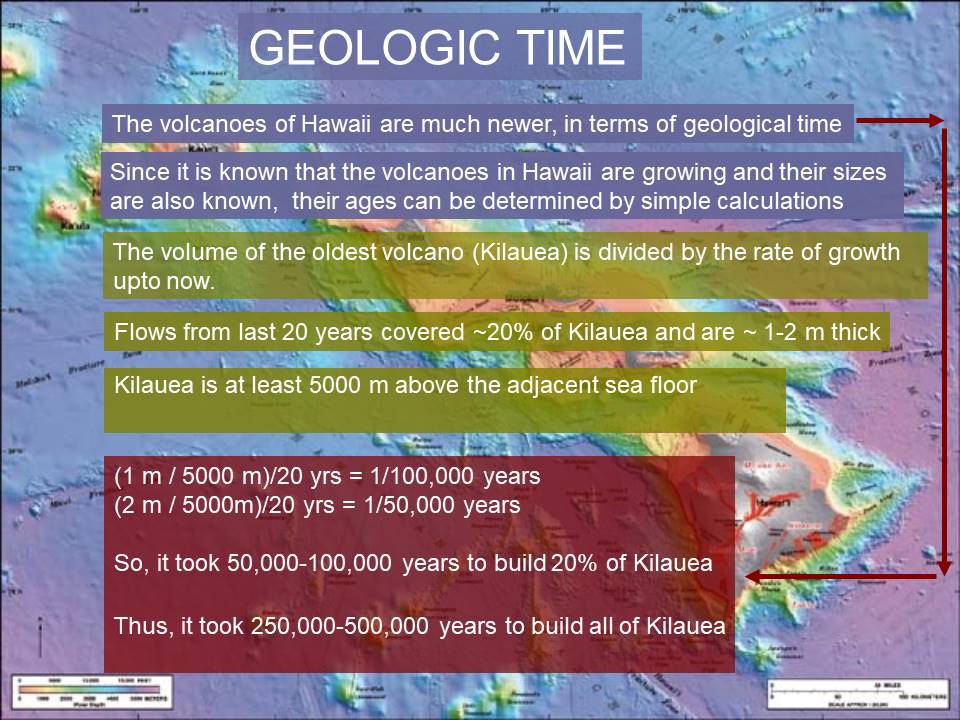
Geological Event
- Hawaii volcanoes are built by thousands of accumulated lava flows.
- Eruptions in the Hawaiian volcanoes are usually preceded by a series of earthquakes.
- These earthquakes open fissures and allow magma to reach the surface.
Plate Tectonics
- The Earth’s plates are in constant, but very slow, motion.
- A hot spot is a point on the Earth’s surface where unusually hot magma impinges on the base of the lithosphere.
- The volcanic mountains creating the Hawaiian islands are among the greatest mountain ranges on earth.
- They rise an average of 4,572 meters (15,000 feet) to reach sea level from their base on the sea floor with the highest (Mauna Loa) climbing an additional 4,170 meters (13,680 feet) above sea level.
- As shield volcanoes, they are built by thousands of accumulated lava flows growing no more than 3 meters (10 feet) at a time to form a broad, gently sloping, flat domed volcanic cone (Clark, 1989).
- Eruptions in the Hawaiian volcanoes are usually preceded by a series of earthquakes which open fissures and allow magma to reach the surface.
- Initially lava fountains, known as “curtains of fire,” hurl streams of lava hundreds of feet into the air from many points along the fissure.
- Hawaiian flows are considered to issue forth relatively quietly since the lava is quite fluid, and the gases escape readily without the disruption of the lava into ash or cinders
- Great floods of lava will then flow down the mountainside.
- Eruptions last from a few days to ten months, frequently followed in two or three years by a flank eruption.
Plate tectonics
- The Earth’s plates are in constant, but very slow, motion.
- Their speed vary with the fastest moving at ten times the rate of the slowest.
- The fastest-moving plates are the oceanic plates, with the Cocos plate having the highest velocity at 8.6 cm per year.
- The giant Pacific plate is the second fastest, moving at 8.0cm per year.
- The slowest-moving plates are the continental plates, because of deep roots which slow their movement.
- They move at a speed of between 0.7cm and 1.1cm per year.
- A hot spot is a point on the Earth’s surface where unusually hot magma impinges on the base of the lithosphere.
- Because the magma from the core is very much hotter than ‘normal’ mantle material, it is lighter, and rises up through the whole of the mantle thickness to impinge on the base of the lithosphere where it melts the rigid rock .
- This molten rock may reach the Earth’s surface by ejection from volcanoes.
- The Hawaiian islands result from a mantle plume impinging on an oceanic plate, which is moving relatively rapidly, and simply ‘floats over’ the hot spot.
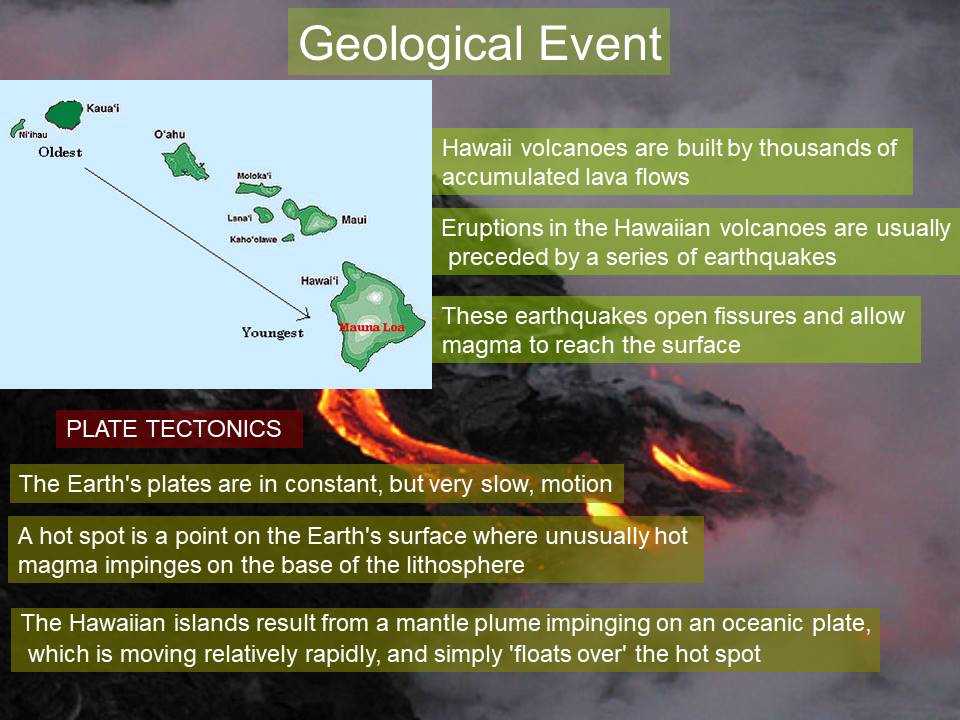
Weathering and Erosion
- Volcanic mountains are subject to the effects of erosion.
- Unless lava continues to flow, the whole mass could wear away.
- Erosion happens mainly as a result of weathering – the effect of water (Mechanical weathering), temperature and wind on the landscape.
- Water causes much erosion. When it falls as acid rain, it can dissolve rocks that are sensitive to acid.
- After volcanic mountains reach the surface, they are subject to the effects of erosion (Moore, 1987).
- Unless lava continues to flow, the whole mass could wear away.
- Erosion happens mainly as a result of weathering – the effect of water, temperature and wind on the landscape.
- Erosion is a key part of the Rock Cycle.
- It is responsible for forming much of the interesting landscape that is around Hawaii mountains.
- Water causes much erosion.
- When it falls as acid rain, it can dissolve rocks that are sensitive to acid.
- Marble & limestone weather when exposed to the rain.
- When the rain falls very heavily, as in monsoons, then flooding can happen.
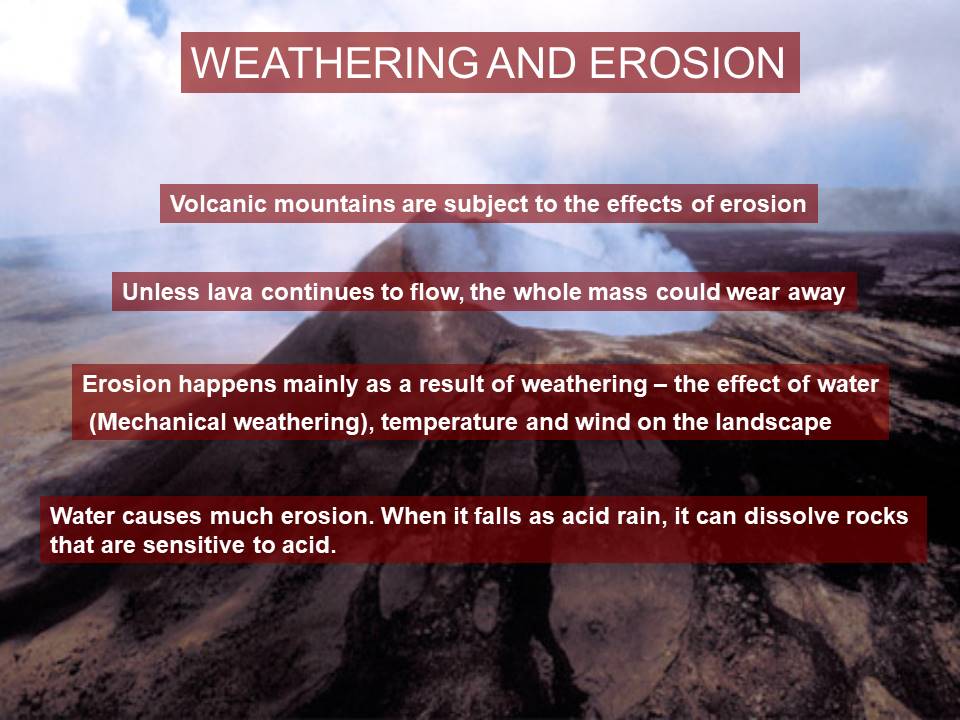
Igneous Rocks
- Lava flowing from a volcano in Hawaii forms igneous rocks.
- In Hawaii, the igneous rocks are the most predominant type.
- Igneous rocks are black when young and turn brown when old.
- The igneous rocks are generally dark due to a high iron and magnesium content.
- Lava flowing from a volcano in Hawaii. forms igneous rocks (MacDonald et al., 1986).
- In Hawaii, this are the igneous rocks are the most predominant.
- Most of these igneous rocks are black or gray when young and turn brown-to-red when old and weathered.
- The lava in Hawaii owes its dark colors to a high iron and magnesium content.
- As it ages, oxidation of the iron creates the orange and red hues.
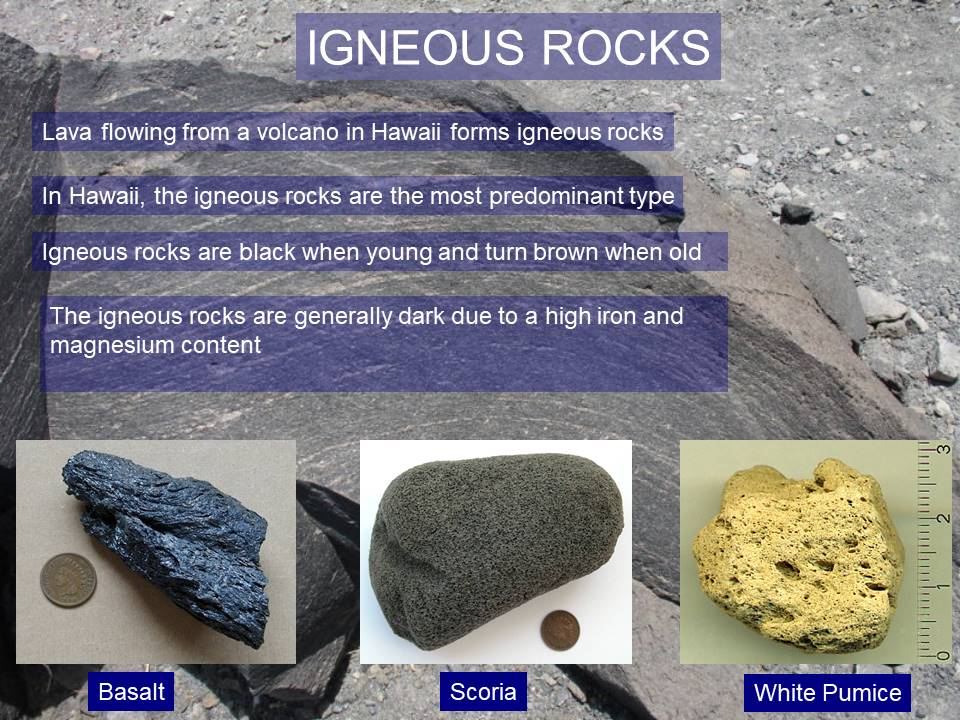
Sedimentary Rocks
Sedimentary rocks are formed in three steps:
- Layers of sediment are deposited at the bottom of seas and lakes.
- Over millions of years the layers get squashed by the layers above.
- The salts that are present in the layers of sediment start to crystallize out as the water is squeezed out.
Examples of sedimentary rocks:
- Sandstone
- Mudstone or shale
- Limestone
- Conglomerate
- Sedimentary rocks are formed in three steps:
- Layers of sediment are deposited at the bottom of seas and lakes.
- Over millions of years the layers get squashed by the layers above.
- The salts that are present in the layers of sediment start to crystallize out as the water is squeezed out.
- These salts help to cement the particles together
- Sedimentary rocks will often have layers or bands across them.
- It will often contain fossils which are fragments of animals or plants preserved within the rock. Only sedimentary rocks contain fossils.
- The rock will tend to scrape easily and often crumble easily.
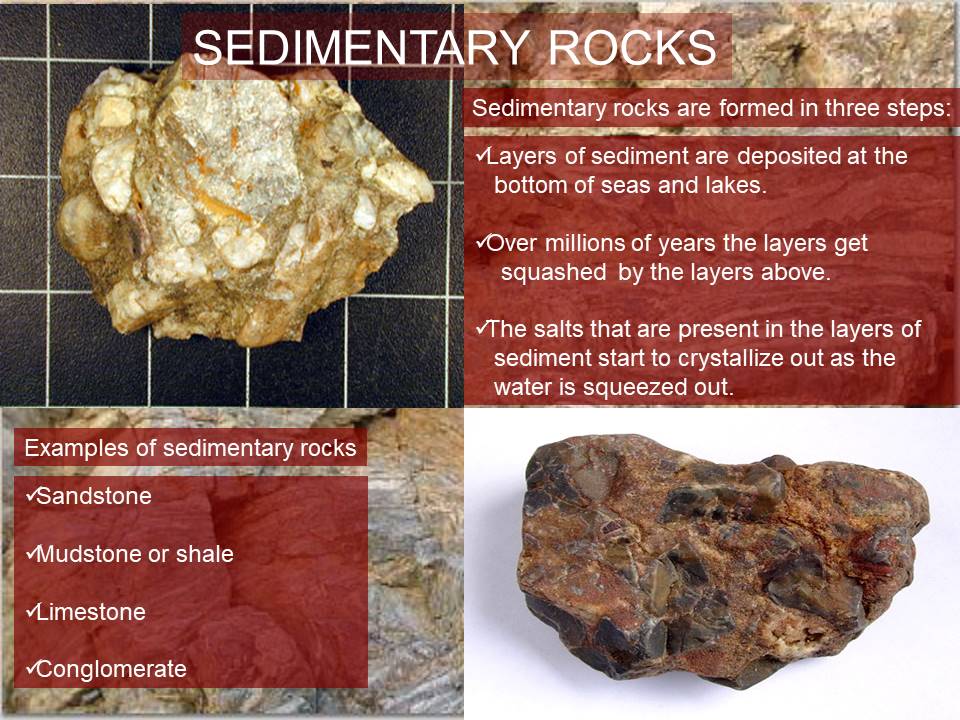
Metamorphic Rocks
- Metamorphic rocks are the least common in Hawaii volcanoes
- Metamorphic rocks are igneous or sedimentary rocks that have been transformed by great heat or pressure
- When the earth’s crust moves, it causes to get squeezed so hard that the heat causes the rock to change.
- Marble is an example of a sedimentary rock that has been changed into a metamorphic rock
- Metamorphic rocks are rocks that have changed.
- The word comes from the Greek “meta” and “morph” which means to change form.
- Metamorphic rocks were originally igneous or sedimentary, but due to movement of the earth’s crust, were changed.
- When the earth’s crust moves, it causes rocks to get squeezed so hard that the heat causes the rock to change.
- Marble is an example of a sedimentary rock that has been changed into a metamorphic rock.
- Metamorphic rocks are the least common of the 3 kinds of rocks.
- Metamorphic rocks are igneous or sedimentary rocks that have been transformed by great heat or pressure.
- Foliated metamorphic rocks have layers, or banding.
- Slate is transformed shale. It splits into smooth slabs.
- Schist is the most common metamorphic rock.
- Gneiss has a streaky look because of alternating layers of minerals.
- Mica is the most common mineral.
- Non-foliated metamorphic rocks are not layered.
- Marble is transformed limestone.
- Quartzite is very hard.
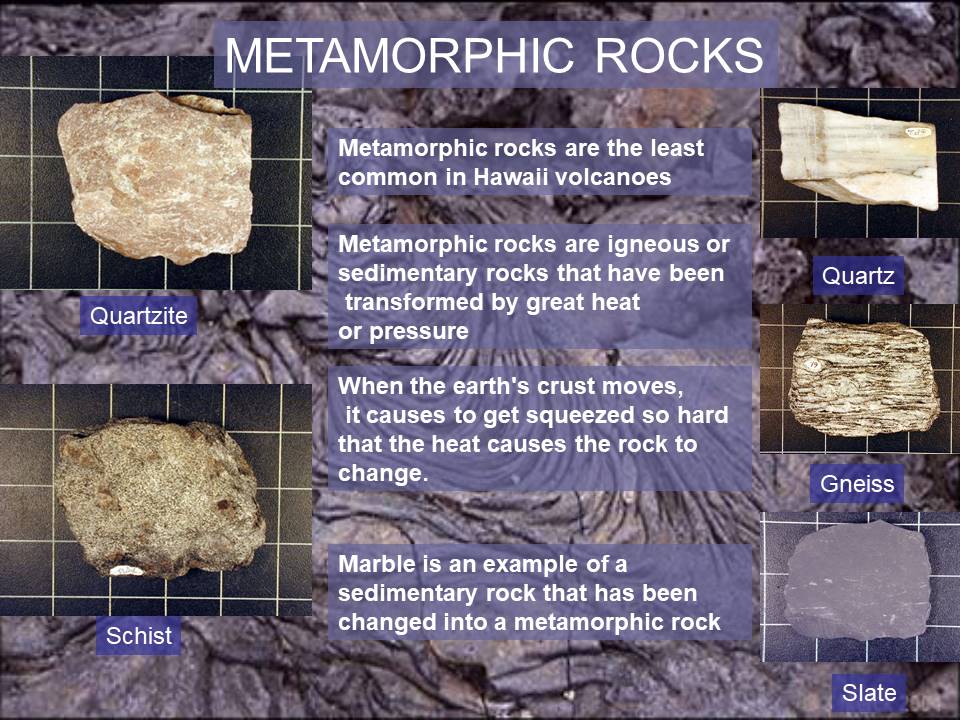
Water, Desert, and Glaciers
- 36 square miles of Hawaii are covered by water
- Hawaii is protected by the high cliffs of the mountains with waterfalls falling into the ocean
- The Kau Desert which is part of Hawaii Volcanoes National Park. It is formed by the rain shadow which leaves one side of the mountain relatively dry
- Geologists have long recognized deposits formed by glaciers on Mauna Kea during recent ice ages
- 36 square miles of Hawaii are covered by water (Moberly Jr., 1963).
- The north and southeastern coast of Hawaii is protected by high cliffs with waterfalls falling over the edge into the ocean below
- Thousands of gently sloping basaltic lava flows that comprise the bulk of the island volcanoes are a vital part of hawaiis water resources
- The structural features associated with these flows such as voids between flows, shrinkage fractures, lava beds make rocks highly permeable hence water storage regions.
The Kau Desert which is part of Hawaii Volcanoes National Park is formed by the rain shadow.
As the volcanic mountains drive the wet air up as the trade winds and force it to drop out the water as rain so the air on the other side of the mountain is relatively dry.
Geologists have long recognized deposits formed by glaciers on Mauna Kea during recent ice ages.
The latest work indicates that deposits of three glacial episodes since 150,000 to 200,000 years ago are preserved on the volcano
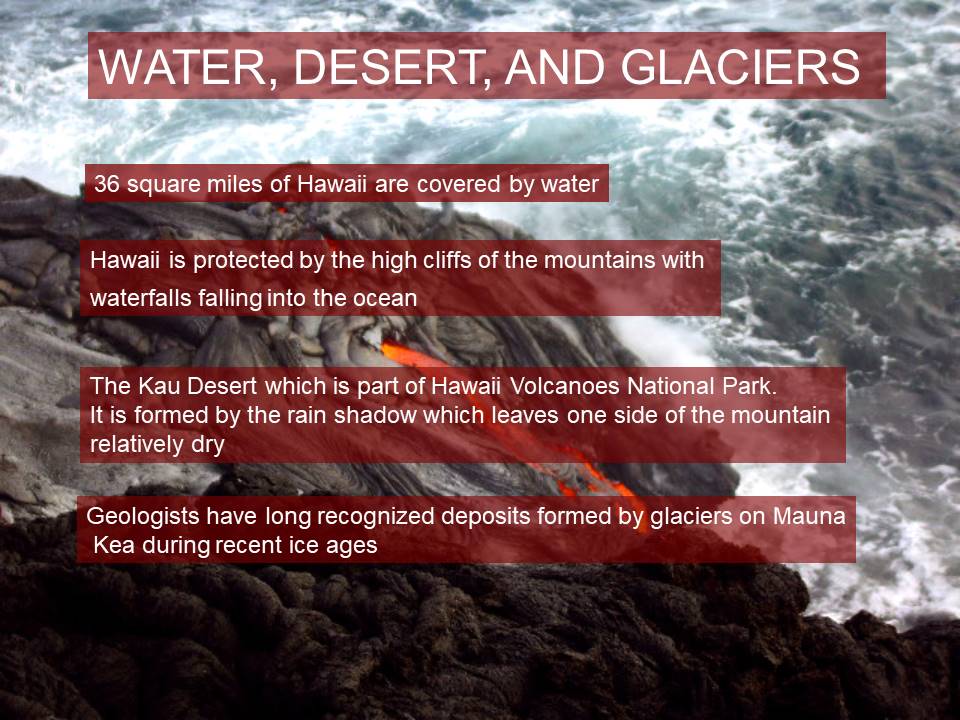
Resources
- The Hawaiian Islands are created by volcanoes
- The active and dormant volcanoes of Hawaii are an integral part of the lives of the people who live there
- Eruptions by virtue of the fact that they are a rare occurrence attract a lot of tourists to the island
- The unique landscapes and water features also attract tourism revenue
- Volcanoes harbor a lot of mineral resources most of which are exported to other countries
- The Hawaiian Islands are created by volcanoes.
- The active and dormant volcanoes of Hawaii are an integral part of the lives of the people who live there
- The unique landscapes and eruptions by virtue of the fact that they are a rare occurrence attract a lot of tourists to the island, hence increased revenue to the people who live there
- Volcanoes produce a lot of mineral resources most of which are exported to other countries where they are used to produce a number of important commodities. These exports contribute to the revenue of the region.
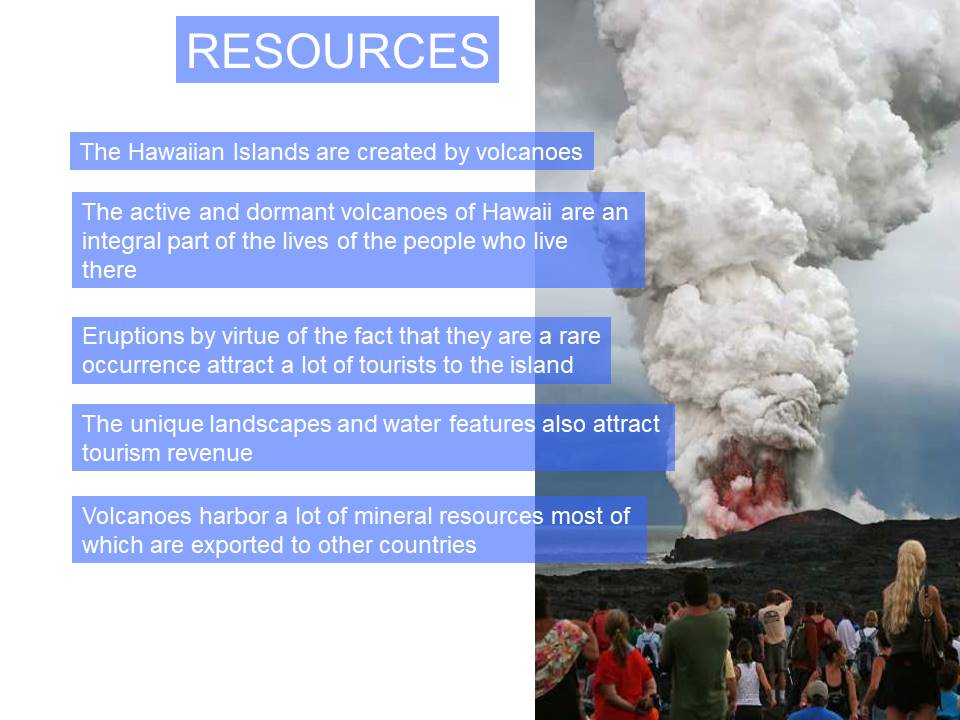
Conclusion
- The Hawaii series of volcanoes was chosen for this presentation
- This is because it has one of the most active volcanoes in the world
- The Hawaii volcanoes were also chosen as a topic of discussion because of the broad nature of the features in the area. For instance, it is very difficult to find an individual feature that has a desert and glaciers all in the same region
- In conclusion, It is worth noting that the Hawaii range of volcanoes is a large area with varied features and cannot be exhaustively discussed in one sitting
- The Hawaii series of volcanoes was chosen for this presentation
- This is because it has one of the most active volcanoes in the world
- The Hawaii volcanoes were also chosen as a topic of discussion because of the broad nature of the features in the area. For instance, it is very difficult to find an individual feature that has a desert and glaciers all in the same region
- In conclusion, It is worth noting that the Hawaii range of volcanoes is a large area with varied features and cannot be exhaustively discussed in one sitting
